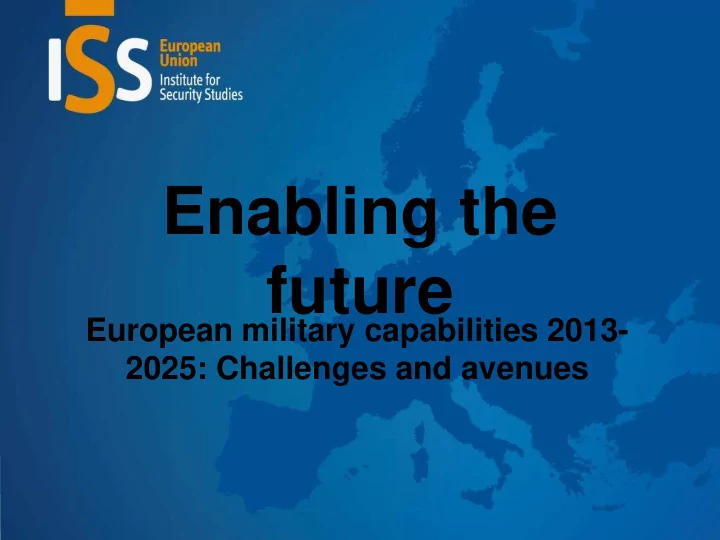

Enabling the future European military capabilities 2013- 2025: Challenges and avenues
Overview • State of play • Successes • Shortfalls • Trends • ‘Strategic interests’ • Avenues • Conclusions
State of play • The EU possesses capable and effective armed forces alongside an advanced industrial and scientific base. • Yet, in general suffers from: – limited awareness of emerging challenges; – basic disinterest in strategic matters; – segmented political and institutional landscape regarding defence and military matters.
Successes • Retirement of Cold War-era equipment; • Adoption of new military doctrines and struc-tures; • Shift towards professional, smaller, all-volunteer forces. • The consolidation of cooperation within the EU: 1) Common Foreign and Security Policy (CFSP) and Common Security and Defence Policy (CSDP); 2) European Defence Agency (EDA); 3) European External Action Service (EEAS).
Shortfalls • Flatlining or decreas-ing defence budgets (exacerbated by the financial crisis); • Modest deployabil-ity levels; • Fragmenta-tion of the EU defence equipment market; • EU pol-icy spread across distinct and often separate ‘boxes’; • General reluctance to make the maintenance of effective armed forces a political priority. • These could cause: – additional re-ductions in EU military capacity; – a potential exodus of the defence industry; – a loss of technological leadership; – In short, creeping ‘demilitarisation’ coupled with at least partial deindustrialisation.
Trends 2013- 2025 • Combination of dynamic instability and systemic interdependence; • Rise of new regional powers and players (particularly in Asia); • The US ‘pivot’; • Greater globalisation; • Developments relating to new weap-onry.
‘Strategic interests’ The EU may also need to reassess its ‘strategic interests’ (as mentioned, but not defined in art.26 of the Lisbon Treaty). These could now well include, along with a peaceful, stable and prosperous neighbourhood: Safeguarding the European ‘homeland’ from 1) attacks, as perpetrated by (surrounding or distant) state or non-state actors; 2) Securing maritime communication lines and strategic communications infrastruc-ture from block-ade or hostile actions; 3) Protecting supplies of energy and raw materials in overseas territories and remote lands from exploitation or annexation by foreign players; 4) Maintaining regional balances of power(s) which favour European values and requirements, namely through international law and an inclusive multilateral system.
Consequences • What sort of armed forces are Europeans likely to have (and need) by 2025? • How might Europeans better organise themselves to take part in the new global competition for wealth, influence and power? • The only solution to counter potential risks is to do more together .
Avenues
Avenue 1 • Implementing consolidation to generate military efficiency . • This suggests a coordinated reduction of redundant and obsolete capabilities to generate immedi-ate and future savings; • In order to facilitate this task, member states may consider asking the EEAS and its specialised bodies to undertake, in close cooperation with the EDA, a targeted EU Military Review.
Avenue 2 • Favouring optimisation to boost military effectiveness . • With respect to equipment, the EU member states could devise a framework whereby armed forces cooperate across service lines for the development of future capabilities; • A second solution would be to introduce a new procurement concept – ‘total life -cycle EU-wide management’ – for new military capabilities.
Avenue 3 • Promoting innovation to enhance military technology . • Innovation is not only a source of efficiency and effectiveness, but also of technological advancement; • This option proposes some tailored solutions to promote innovation, which also include borrowing ideas from funding schemes originally adopted by NATO or pro-posed by the European Commission in other policy areas.
Avenue 4 • Framing and reinforcing regionalisation to bolster operational width and depth . • Targeted (bilateral or mini-lateral) integration could lead to pay-offs in the maintenance and acquisition of a wider spectrum – and, to some extent, greater depth – of military forces; • This will especially be the case if these ‘islands’ of coop-eration established by some EU countries with their neighbours or partners can be coordinated at EU level, so as to form an ‘archipelago’.
Avenue 5 • Moving towards integration to further increase depth and elevate sustain-ability . • Bringing together the armed forces of member states under an EU-wide force structure would enable Europeans to vastly boost their logistical capacity and under-take the most demanding operations that any future security environment may ne-cessitate; • This may require establishing a new ‘family’ of targeted Headline Goals for 2025 and synchronising national armament programmes and procurement cycles.
Conclusions • Europe-ans are losing sovereignty by not consolidating, not optimising, not innovat-ing, not regionalising and not integrating their military capabilities; • Policy challenges call for a common, systematic, comprehensive and regular (re)assessment of ends, ways and means; • Lessons, examples and cases of best practise can be drawn - and duly adapted – from other policy areas (mostly civilian) as well as from mini-lateral and NATO cooperation; • All avenues require political decisions at the highest level to match the political rhetoric – the European Council in December should therefore represent a point of departure rather than arrival.
Recommend
More recommend